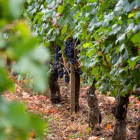For both casual and avid wine drinkers alike, tasting notes are an important barometer in gauging how likely one is to enjoy that particular wine. From the blurb on the bottle’s label to in-depth write-ups by esteemed critics, wine notes aim to give the reader a solid understanding of what they’re about to taste.
But they also play a crucial retrospective role. Enthusiasts take their own notes to help recall the characteristics of a specific wine and how to differentiate between them, not to mention particular standout bottles and ones to avoid in future. While the memory of tasting a few wines may last for several days or even a few weeks, when you taste many wines in a relatively short period of time (or many wines frequently, like wine pros), they can be hard to accurately remember down to the last detail. Of course, the best and worst wines almost always stick out, but the vast majority of wines fall somewhere in between. This is why it’s important to take useful tasting notes.
Unless you’re taking a wine exam or are purposefully writing notes for the benefit of others, such notes need only be personal to you. There’s no right or wrong way to take wine notes, they only need evoke your memory of the wine – you’re writing for your eyes only.
It is, of course, important to keep your notes consistent, so that wines can be compared against one another fairly, and working to a basic template will ensure you don’t miss any key aspects of a wine. Once you’re comfortable with the basics, you can adapt your style over time to include extra flourishes that work with your way of thinking. Perhaps the wine evokes memories of a particular time or place? Maybe it reminds you of a piece of music? Perhaps you can envision drinking it in a very particular setting? If these cues work for you, then write them down! And don’t be afraid to write things that might sound silly – these are your personal notes, after all.
Finally, remember that wine tasting notes are designed to be useful, so while it’s important to include your own voice in your musings, don’t make it too flowery. You’re writing helpful guidance for your future self, not a submission to Poetry London! Here are the basic elements to cover.
1. The details
This is the wine’s basic identifying information, so be sure to include:
- The producer
- The wine’s full name
- The vintage
- Region of origin
- Grape variety or varieties
- Wine alcohol percentage
- Price
You might also want to include anything interesting in relation to its history, winemaker or vineyard – these types of details can be a useful memory trigger when sets of notes otherwise seem similar.
2. Appearance
Thanks to our improved understanding of winemaking processes, appearance is perhaps less important than it used to be. Obviously note the colour – red or white – but otherwise you need only focus on particularly unusual elements – if it’s very pale or dark given its variety, or if it’s cloudy, for example. It’s worth giving extra attention to rose and sparkling wines, though, as their appearances can be much more diverse.
3. Aromas and flavours
This is where tasters tend to obsess the most about their notes, given the almost limitless number of descriptors that can be used to describe a particular flavour (check out our A-Z of terms, here). The wine might have berry aromas, but what type of berry? Adjectives are useful!
This is where a wide range of vocabulary comes in handy, lest every note describe a wine as ‘plum’ or ‘herbal’, making it harder to tell them apart when you revisit them in future. Consider subcategories of common terms – fruit, for example, can be broken down into citrus fruits, melon, pit fruits, seed fruits and tropical fruits.
Other things to note are whether the aromas and flavours are subtle or powerful, and whether or not they change in the glass.
Learn more about tasting and developing your palate here, as well as the role of smell in wine tasting, here.
4. Structure
A wine’s structure is comprised of many parts, although the main ones are acidity (refreshment), tannins (dryness), body, alcohol and texture. For beginners, it’s helpful to approach these with a straightforward low-medium-high scale, and using + and – marks to modify where necessary. Learn more about the basic characteristics of wine, here.
5. Finish
The finish refers to how long the taste remains on your palate – generally speaking, the longer the finish, the higher the quality of wine. Again, a simple short-medium-long scale works just fine, although you might also note the style of the aftertaste, and whether it is tingly and tart, soft and smooth, or fresh and juicy.
6. Overall impressions
Here, you can sum up your final thoughts with a rating (number of stars, marks out of 10, and so on) as well as freestyle your impressions with any notes that don’t ‘fit’ in the above sections. This will help you to distinguish between your favourite wines even if their tasting notes are almost equally positive.






